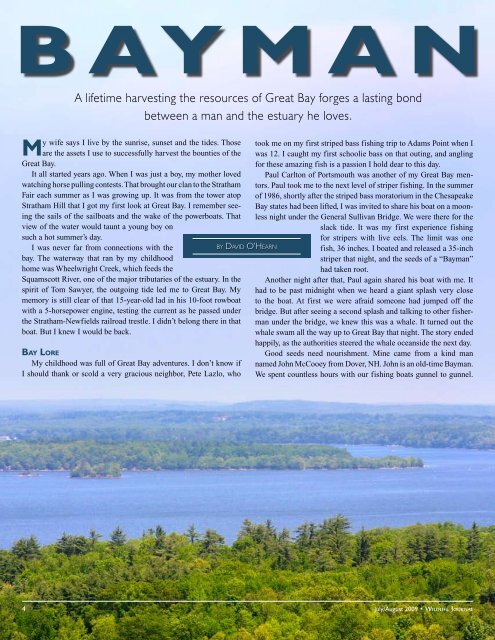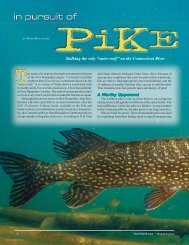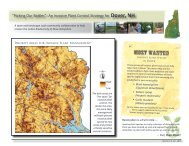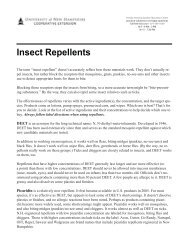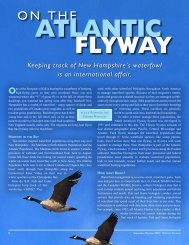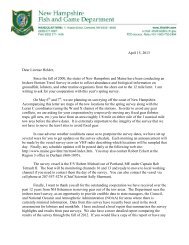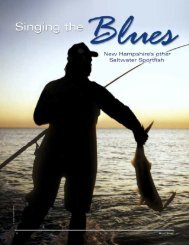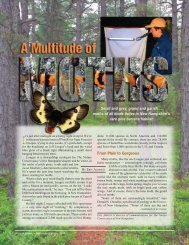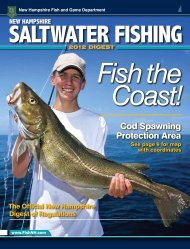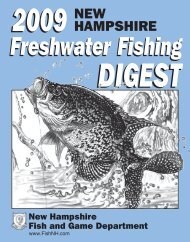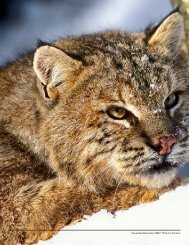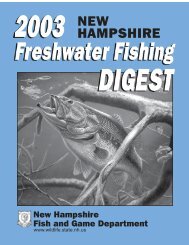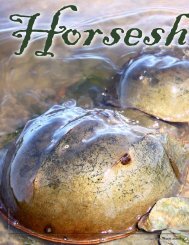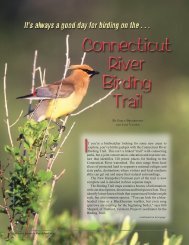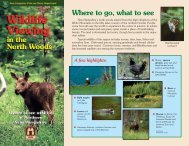A lifetime harvesting the resources of Great Bay - New Hampshire ...
A lifetime harvesting the resources of Great Bay - New Hampshire ...
A lifetime harvesting the resources of Great Bay - New Hampshire ...
You also want an ePaper? Increase the reach of your titles
YUMPU automatically turns print PDFs into web optimized ePapers that Google loves.
B ay m a n<br />
A <strong>lifetime</strong> <strong>harvesting</strong> <strong>the</strong> <strong>resources</strong> <strong>of</strong> <strong>Great</strong> <strong>Bay</strong> forges a lasting bond<br />
between a man and <strong>the</strong> estuary he loves.<br />
My wife says I live by <strong>the</strong> sunrise, sunset and <strong>the</strong> tides. Those<br />
are <strong>the</strong> assets I use to successfully harvest <strong>the</strong> bounties <strong>of</strong> <strong>the</strong><br />
<strong>Great</strong> <strong>Bay</strong>.<br />
It all started years ago. When I was just a boy, my mo<strong>the</strong>r loved<br />
watching horse pulling contests. That brought our clan to <strong>the</strong> Stratham<br />
Fair each summer as I was growing up. It was from <strong>the</strong> tower atop<br />
Stratham Hill that I got my first look at <strong>Great</strong> <strong>Bay</strong>. I remember seeing<br />
<strong>the</strong> sails <strong>of</strong> <strong>the</strong> sailboats and <strong>the</strong> wake <strong>of</strong> <strong>the</strong> powerboats. That<br />
view <strong>of</strong> <strong>the</strong> water would taunt a young boy on<br />
such a hot summer’s day.<br />
I was never far from connections with <strong>the</strong><br />
bay. The waterway that ran by my childhood<br />
home was Wheelwright Creek, which feeds <strong>the</strong><br />
Squamscott River, one <strong>of</strong> <strong>the</strong> major tributaries <strong>of</strong> <strong>the</strong> estuary. In <strong>the</strong><br />
spirit <strong>of</strong> Tom Sawyer, <strong>the</strong> outgoing tide led me to <strong>Great</strong> <strong>Bay</strong>. My<br />
memory is still clear <strong>of</strong> that 15-year-old lad in his 10-foot rowboat<br />
with a 5-horsepower engine, testing <strong>the</strong> current as he passed under<br />
<strong>the</strong> Stratham-<strong>New</strong>fields railroad trestle. I didn’t belong <strong>the</strong>re in that<br />
boat. But I knew I would be back.<br />
<strong>Bay</strong> Lore<br />
My childhood was full <strong>of</strong> <strong>Great</strong> <strong>Bay</strong> adventures. I don’t know if<br />
I should thank or scold a very gracious neighbor, Pete Lazlo, who<br />
by David O’Hearn<br />
took me on my first striped bass fishing trip to Adams Point when I<br />
was 12. I caught my first schoolie bass on that outing, and angling<br />
for <strong>the</strong>se amazing fish is a passion I hold dear to this day.<br />
Paul Carlton <strong>of</strong> Portsmouth was ano<strong>the</strong>r <strong>of</strong> my <strong>Great</strong> <strong>Bay</strong> mentors.<br />
Paul took me to <strong>the</strong> next level <strong>of</strong> striper fishing. In <strong>the</strong> summer<br />
<strong>of</strong> 1986, shortly after <strong>the</strong> striped bass moratorium in <strong>the</strong> Chesapeake<br />
<strong>Bay</strong> states had been lifted, I was invited to share his boat on a moonless<br />
night under <strong>the</strong> General Sullivan Bridge. We were <strong>the</strong>re for <strong>the</strong><br />
slack tide. It was my first experience fishing<br />
for stripers with live eels. The limit was one<br />
fish, 36 inches. I boated and released a 35-inch<br />
striper that night, and <strong>the</strong> seeds <strong>of</strong> a “<strong>Bay</strong>man”<br />
had taken root.<br />
Ano<strong>the</strong>r night after that, Paul again shared his boat with me. It<br />
had to be past midnight when we heard a giant splash very close<br />
to <strong>the</strong> boat. At first we were afraid someone had jumped <strong>of</strong>f <strong>the</strong><br />
bridge. But after seeing a second splash and talking to o<strong>the</strong>r fisherman<br />
under <strong>the</strong> bridge, we knew this was a whale. It turned out <strong>the</strong><br />
whale swam all <strong>the</strong> way up to <strong>Great</strong> <strong>Bay</strong> that night. The story ended<br />
happily, as <strong>the</strong> authorities steered <strong>the</strong> whale oceanside <strong>the</strong> next day.<br />
Good seeds need nourishment. Mine came from a kind man<br />
named John McCooey from Dover, NH. John is an old-time <strong>Bay</strong>man.<br />
We spent countless hours with our fishing boats gunnel to gunnel.<br />
<br />
July/August 2009 • Wildlife Journal
I loved to listen to his stories <strong>of</strong><br />
<strong>Great</strong> <strong>Bay</strong>’s past. John was <strong>the</strong><br />
fertilizer I needed.<br />
When I was growing up, it<br />
was a neighborhood tradition to<br />
see who could construct <strong>the</strong> best<br />
smelt shanty. Those shacks were<br />
hauled down to Depot Road in<br />
Stratham, N.H. I remember one<br />
even had bunks. At that time, <strong>Great</strong> <strong>Bay</strong> was <strong>the</strong> hotbed for winter<br />
smelt fishing. The smelt camps in Greenland and <strong>New</strong>ington were<br />
in full operation. Over <strong>the</strong> years, ice conditions and slow fishing<br />
caused <strong>the</strong> shanty city to move to <strong>the</strong> Squamscott River. We are seeing<br />
a reversal <strong>of</strong> that trend now, as <strong>Great</strong> <strong>Bay</strong> once again boasted<br />
some <strong>of</strong> <strong>the</strong> best area smelt fishing this past winter.<br />
During my teenage years, <strong>the</strong> <strong>New</strong> <strong>Hampshire</strong> Fish and Game<br />
Department tried to establish a coho salmon fishery in <strong>Great</strong> <strong>Bay</strong>.<br />
I remember standing on <strong>the</strong> shores <strong>of</strong> Moody Point in <strong>New</strong>market,<br />
before <strong>the</strong> blades <strong>of</strong> development had transformed <strong>the</strong> land, and<br />
watching those silvery salmon jumping clear out <strong>of</strong> <strong>the</strong> water. The<br />
end came for many salmon in Wheelwright Creek. I remember being<br />
in awe <strong>of</strong> <strong>the</strong> size <strong>of</strong> those red salmon as <strong>the</strong>y spawned and died in<br />
such a small brook.<br />
©David O’Hearn photo<br />
Author Dave O’Hearn with two “keepah lobstahs.”<br />
On <strong>the</strong> Water<br />
It’s hard to be a man <strong>of</strong> <strong>the</strong> bay<br />
without a boat. So, after much<br />
pleading and negotiating, my “better<br />
half ” gave in, and I purchased<br />
a 17-foot center-console craft in<br />
1990. I soon learned <strong>the</strong> ins and<br />
outs <strong>of</strong> launching and retrieving<br />
my boat at Chapman’s Landing in Stratham. This, in turn, launched<br />
a new chapter in my career as a <strong>Bay</strong>man.<br />
Some <strong>of</strong> my fondest memories are <strong>of</strong> catching alewives in <strong>the</strong><br />
headwaters <strong>of</strong> <strong>the</strong> Squamscott River. From downtown Exeter, I<br />
would motor to Adams Point with a live-well full <strong>of</strong> those little silver<br />
fish. The striper fishing action was hot. I remember using those<br />
alewives as bait was like feeding candy to babies!<br />
Late summer brings <strong>the</strong> menhaden or “pogies” into <strong>the</strong> <strong>Great</strong><br />
<strong>Bay</strong>. Menhaden are ano<strong>the</strong>r favorite food <strong>of</strong> <strong>the</strong> striped bass. Last<br />
year was very special. I got to share a couple weekends with my son<br />
live-lining pogies for striped bass at Adams Point. It was definitely<br />
quality time.<br />
Having my own boat gave me <strong>the</strong> ability to explore and harvest<br />
<strong>the</strong> clam flats <strong>of</strong> <strong>Great</strong> <strong>Bay</strong>, something I love because from an early<br />
©nhfg / victor young photo<br />
Wildlife Journal • July/August 2009
In longstanding tradition,<br />
<strong>Bay</strong>men meet on<br />
<strong>the</strong> mud flats <strong>of</strong> <strong>Great</strong><br />
<strong>Bay</strong> on a September<br />
Saturday for <strong>the</strong> first<br />
day <strong>of</strong> clamming season.<br />
©David O’Hearn photo<br />
An engine chugs across<br />
<strong>the</strong> Stratham-<strong>New</strong>fields<br />
railroad trestle over <strong>the</strong><br />
Squamscott River near<br />
<strong>Great</strong> <strong>Bay</strong>.<br />
Previous page and<br />
below: Still stunning<br />
today, <strong>the</strong> expansive<br />
view <strong>of</strong> <strong>Great</strong> <strong>Bay</strong><br />
from <strong>the</strong> fire tower<br />
in Stratham Hill Park<br />
inspired <strong>the</strong> author as<br />
a boy.<br />
age, I had acquired a taste for s<strong>of</strong>tshell clams. There is<br />
a <strong>Bay</strong>man tradition that continues to this day – all <strong>the</strong><br />
“old salts” like to meet at <strong>the</strong> flats on <strong>the</strong> first day <strong>of</strong><br />
clamming each September. It is a good place to share<br />
a beverage and catch up on each o<strong>the</strong>r’s activities. The<br />
oyster tongers are <strong>the</strong>re too. If we’re lucky and <strong>the</strong><br />
water is clear, we can pick a couple gallons <strong>of</strong> oysters<br />
right <strong>of</strong>f <strong>the</strong> bottom. This is a day I look forward to<br />
each year.<br />
Lobstering<br />
Like any good tree with strong roots and a straight<br />
trunk, branches started to appear – my interest in <strong>the</strong><br />
bay deepened as I discovered new possibilities. Two<br />
<strong>of</strong> my good friends, Joe Daley and Mark Doll<strong>of</strong>f <strong>of</strong><br />
<strong>New</strong>fields, N.H., were trapping lobster in <strong>the</strong> <strong>Great</strong><br />
<strong>Bay</strong> estuary. After a couple adventures on <strong>the</strong>ir boat, I<br />
knew this was something I had to try.<br />
Who would have thought so far from <strong>the</strong> ocean we<br />
would have American lobster? The nursery <strong>of</strong> <strong>Great</strong><br />
<strong>Bay</strong> plays a special role for <strong>the</strong> lobster. Each spring,<br />
lobsters migrate from <strong>the</strong> ocean into <strong>Great</strong> <strong>Bay</strong> to<br />
shed or “molt” <strong>the</strong>ir shell. The lobsters come for <strong>the</strong><br />
mud that dominates <strong>the</strong> floor <strong>of</strong> <strong>the</strong> estuary. After a<br />
lobster sheds its shell, it is very vulnerable to predators.<br />
Lobsters use holes in <strong>the</strong> mud to hide in while<br />
<strong>the</strong>ir new shell hardens. <strong>Great</strong> <strong>Bay</strong> is a good place<br />
to see <strong>the</strong> difference between a hard shell (recently<br />
arrived from <strong>the</strong> ocean) and s<strong>of</strong>t shell (new shell<br />
hardening) lobster. A hard-shell <strong>Great</strong> <strong>Bay</strong> lobster is<br />
quite a delicacy.<br />
I started with five traps. Those five traps grew to<br />
ten, and <strong>the</strong>n to twenty, in <strong>the</strong> first few years I trapped.<br />
I had outgrown <strong>the</strong> center console and started searching<br />
for a genuine lobster boat. In 1997, I purchased<br />
a 1972 18-foot Norton, originally made in Hampton,<br />
N.H. I equipped it with a 75-horsepower Yamaha.<br />
Then things came full circle – a boat slip became<br />
available on <strong>the</strong> Squamscott River. The USS Coalman<br />
had found a new home.<br />
©David O’Hearn photo<br />
Call <strong>of</strong> <strong>the</strong> <strong>Bay</strong><br />
It is hard to describe <strong>the</strong> feeling I get each time<br />
I pass under <strong>the</strong> Stratham-<strong>New</strong>fields trestle into<br />
<strong>Great</strong> <strong>Bay</strong>. The first thing to come into view is Mount<br />
Agamenticus in York, Maine. As I bear left in <strong>the</strong><br />
channel along Black Bank, <strong>the</strong> Labonte Farm and <strong>the</strong><br />
mouth <strong>of</strong> <strong>the</strong> Lamprey River come into view. When I<br />
reach <strong>the</strong> point where <strong>the</strong> Squamscott and Lamprey<br />
rivers converge into <strong>Great</strong> <strong>Bay</strong>, I can see <strong>the</strong> Stratham<br />
Hill tower. It makes me chuckle, thinking <strong>the</strong>re may<br />
be a young boy or girl at that very moment, standing<br />
<br />
July/August 2009 • Wildlife Journal
atop <strong>the</strong> tower, watching my wake and dreaming <strong>of</strong><br />
<strong>the</strong>ir day on <strong>Great</strong> <strong>Bay</strong>.<br />
A very special friend and my favorite <strong>Bay</strong>man is<br />
Dick Pinney <strong>of</strong> Greenland, N.H. Dick guides striper<br />
fishermen in <strong>the</strong> <strong>Great</strong> <strong>Bay</strong> during <strong>the</strong> summer. A<br />
few years ago, my bro<strong>the</strong>r-in-law and I took a <strong>Great</strong><br />
<strong>Bay</strong> charter with Dick. The memories and knowledge<br />
shared that day will last a <strong>lifetime</strong>. I sometimes envy<br />
some <strong>of</strong> <strong>the</strong> accounts <strong>of</strong> Dick’s adventures on <strong>Great</strong><br />
<strong>Bay</strong>. But as I compare his experiences to mine, I find<br />
we share much common ground – a powerful appreciation<br />
for <strong>the</strong> rich <strong>resources</strong> and natural beauty <strong>of</strong><br />
<strong>the</strong> <strong>Bay</strong>.<br />
Learning from <strong>the</strong>se adventurers who plied <strong>the</strong><br />
bay before me, I, too, have become a <strong>Bay</strong>man. When<br />
I am out on <strong>Great</strong> <strong>Bay</strong>, my internal clock tells me I<br />
was born 200 years too late. I want to be for a day<br />
that Native American who paddled his canoe from<br />
Thompson Point across <strong>the</strong> strait to Adams Point. I<br />
want to see <strong>the</strong> racks <strong>of</strong> salmon drying in <strong>the</strong> sun. I<br />
want to hunt deer and wild turkey on <strong>the</strong> shores <strong>of</strong> <strong>the</strong><br />
<strong>Great</strong> <strong>Bay</strong>, where towering mast pines once stood.<br />
As each spring approaches, I feel my blood thickening<br />
with salt. It is a mineral smell that washes <strong>the</strong><br />
winter from my blood. There is new life to see and<br />
new adventures to be had. The <strong>Great</strong> <strong>Bay</strong> calls me to<br />
her shores. I am proud to be a <strong>Bay</strong>man.<br />
David O’Hearn is a lifelong resident (49 years) <strong>of</strong><br />
Exeter, N.H. He and his wife Karen have two sons,<br />
Adam and Shawn. Follow his adventures on <strong>the</strong> bay<br />
and at his hunting, fishing and trapping camp on his<br />
blog, huntingresource.com/coalman.html.<br />
©David O’Hearn photo<br />
The author gained much<br />
<strong>of</strong> his knowledge <strong>of</strong> <strong>Great</strong><br />
<strong>Bay</strong> from old-timers like<br />
outdoor columnist Dick<br />
Pinney, above.<br />
Clockwise from top left: Shawn O’Hearn, <strong>the</strong> author’s son, with striped bass caught<br />
near Adams Point; smelt shanties; sunrise on <strong>Great</strong> <strong>Bay</strong>; <strong>the</strong> U.S.S. Coalman awaits<br />
<strong>the</strong> author’s next <strong>Great</strong> <strong>Bay</strong> adventure.<br />
©David O’Hearn photo<br />
©David O’Hearn photo<br />
©David O’Hearn photo<br />
©hannah clements photo<br />
Wildlife Journal • July/August 2009<br />
<br />
©nhfg / victor young photo


